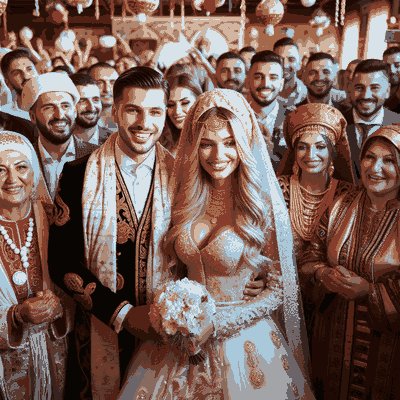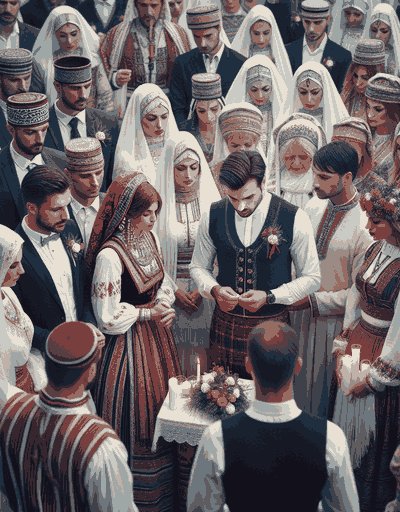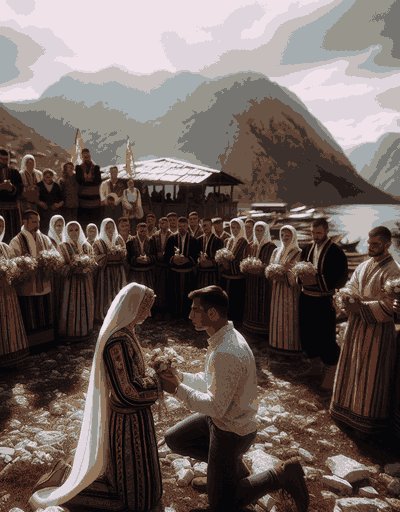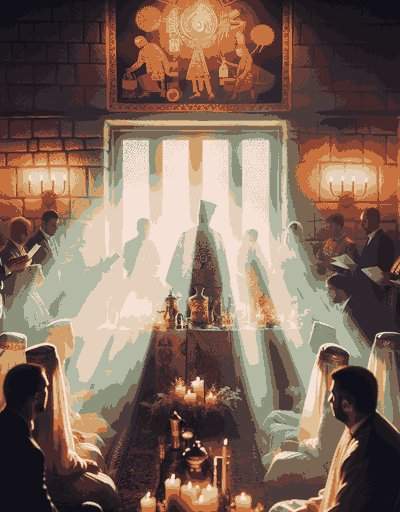Montenegro Wedding Traditions
Montenegrin wedding traditions are centuries-old cultural celebrations that blend Orthodox Christian rituals with distinctive regional customs, creating multi-day festivities that typically involve 150-300 guests and cost between €15,000-€40,000 ($16,500-$44,000). These traditions encompass pre-wedding ceremonies like jabukaYAH-boo-kahsr-ME_jabuka apple rituals, dramatic bride ransom negotiations, the unique apple shooting ceremony, vibrant koloKOH-lohsr-ME_kolo circle dancing, and elaborate wedding feasts featuring regional specialties.

What Are Montenegrin Wedding Traditions?

Montenegrin weddings follow this traditional timeline:
- 3-6 months before: Formal engagement (prosidbaPROH-seed-bah) with family negotiations
- 1-2 weeks before: Bachelor/bachelorette parties (momačko/devojačko večedeh-voh-YAHCH-koh VEH-cheh)
- Wedding morning: Apple shooting ceremony and bride ransom
- Wedding day: Civil ceremony (required), religious ceremony (optional), reception with 150-300 guests
- Day after: Ponavljanjepoh-NAHV-lyah-nyeh after-party celebration
- 1-2 weeks after: First visit to bride’s parents (prvičenjeper-VEE-cheh-nyeh)
The complete celebration costs range from €15,000-€40,000 ($16,500-$44,000), with regional variations:
- Coastal weddings: €25,000-€40,000 ($27,500-$44,000)
- Mountain region weddings: €15,000-€25,000 ($16,500-$27,500)
- Urban center weddings: €20,000-€35,000 ($22,000-$38,500)
Pre-Wedding Traditions and Ceremonies

Prosidba: The Formal Engagement Process
ProsidbaPROH-seed-bahsr-ME_prosidba is the traditional Montenegrin engagement ceremony where the groom’s family formally requests the bride’s hand in marriage, typically occurring 3-6 months before the wedding and involving 20-30 close family members from both sides.
This centuries-old practice includes:
- Traditional gifts: RakijaRAH-kee-yahsr-ME_rakija fruit brandy, wine, and pogačaPOH-gah-chahsr-ME_pogača ceremonial bread
- Family negotiations: Formal discussions between fathers and male relatives
- Modern costs: €500-€1,500 ($550-$1,650) for gifts and celebration
- Duration: 2-4 hour formal gathering
- Current practice: 65% of Montenegrin couples still hold formal engagement ceremonies
Unlike Western traditions focusing on diamond rings, Montenegrin engagements emphasize family unity and formal agreements. Modern couples often blend traditional elements with contemporary touches, hosting engagement parties that cost €1,000-€3,000 ($1,100-$3,300).
Jabuka: The Symbolic Apple Tradition
JabukaYAH-boo-kahsr-ME_jabuka is a pre-wedding apple ritual symbolizing love, fertility, and commitment in Montenegrin culture, where a decorated apple serves as a formal marriage proposal symbol.
Traditional jabuka customs involve:
- Apple decoration: Coins pressed into skin or silk wrapping
- Symbolic meaning: Seeds represent fertility, sweetness represents married life
- Acceptance ritual: Taking the apple confirms engagement
- Regional variations: Coastal areas use citrus alongside apples
- Modern adaptation: 40% of couples incorporate apple symbolism in decorations
The apple tradition dates to pre-Christian Slavic times and remains significant in rural Montenegro, where 75% of traditional families maintain some form of this custom.
Bachelor and Bachelorette Celebrations
Momačko večemoh-MAHCH-koh VEH-chehsr-ME_momačko-veče and devojačko večedeh-voh-YAHCH-koh VEH-chehsr-ME_devojačko-veče are traditional Montenegrin bachelor and bachelorette parties that historically focused on ceremonial farewells to single life rather than revelry.
Contemporary celebrations typically include:
- Duration: 1-2 day events
- Participants: 10-20 close friends
- Costs: €300-€1,500 ($330-$1,650) per person
- Popular locations: Budva coast (45%), mountain retreats (25%), abroad (30%)
- Traditional elements: Ceremonial toasts, advice-giving rituals, folk songs
Modern Montenegrin pre-wedding parties increasingly blend international trends with traditional elements, especially in urban areas where 80% include destination components.
Wedding Ceremony Traditions

Civil Ceremony Requirements
Građansko venčanjeGRAH-jahn-skoh ven-CHAH-nyehsr-ME_građansko-venčanje is the mandatory civil ceremony required for legal marriage recognition in Montenegro, established during the Yugoslav period and lasting 15-30 minutes.
Civil ceremony details:
- Location options: Municipality offices, historic fortresses, seaside venues
- Required attendees: Couple, 2 witnesses, registrar
- Documentation: Birth certificates, single status certificates, passport copies
- Costs: €50-€500 ($55-$550) depending on venue
- Scheduling: Must occur before religious ceremony
Currently, 100% of legal marriages require civil ceremonies, with 60% of couples choosing special venue locations over standard municipality offices.
Orthodox Religious Ceremonies
Venčanjeven-CHAH-nyehsr-ME_venčanje is the traditional Orthodox wedding ceremony featuring the distinctive crowning ritual, sharing of common cup, and triple procession around the altar.
Religious ceremony components:
- Duration: 45-90 minutes
- Key rituals: Crown ceremony, ring exchange, common cup, altar procession
- Participants: Kumkoomsr-ME_kum, priest, couple, witnesses
- Costs: €200-€1,000 ($220-$1,100) including church donation
- Current statistics: 70% of Montenegrin couples have religious ceremonies
The ceremony follows Byzantine liturgical traditions dating back over 1,000 years, with specific prayers and blessings unique to Montenegrin Orthodox practice.
The Role of Kum and Kuma
Kum (sr-ME_kum) is the godfather/best man position considered the most important ceremonial role in Montenegrin weddings, creating a lifelong spiritual kinship called kumstvoKOOM-stvohsr-ME_kumstvo.
Kum responsibilities include:
- Ceremonial duties: Leading procession, holding crowns, first toast
- Financial obligations: Contributing €1,000-€5,000 ($1,100-$5,500) to wedding
- Bride protection: Safeguarding bride during celebrations
- Future obligations: Godfather to couple’s children
- Selection criteria: Chosen from outside family clan for alliance-building
Unlike Western wedding parties with multiple attendants, 95% of traditional Montenegrin weddings feature only the kum and sometimes kumaKOO-mahsr-ME_kuma as principal witnesses.
Gađanje Jabuke: The Apple Shooting Ceremony
Gađanje jabukeGAH-jah-nyeh YAH-boo-kehsr-ME_gađanje-jabuke is Montenegro’s unique apple shooting tradition where the groom’s party must shoot down an apple before retrieving the bride, demonstrating marksmanship skills rooted in the country’s warrior culture.
Apple shooting details:
- Traditional setup: Apple on roof or 5-10 meter pole
- Modern adaptations: Lower heights, toy guns, or symbolic representations
- Success rate: 85% hit within 3 attempts
- Participants: Groom or male relatives
- Regional variations: Mountain regions maintain authentic rifle use (60%)
This tradition reflects Montenegro’s historical emphasis on military prowess, with 70% of rural weddings and 30% of urban weddings including some form of apple shooting.
Otkup Mlade: The Bride Ransom Tradition
Otkup mladeOHT-koop MLAH-dehsr-ME_otkup-mlade is the playful bride ransom negotiation where the groom must “purchase” his bride from her male relatives through payments, gifts, or entertaining tasks.
Ransom negotiation elements:
- Typical demands: €50-€500 ($55-$550) in small bills
- Duration: 20-45 minutes of negotiations
- Participants: 5-10 male relatives blocking entrance
- Modern tasks: Trivia about bride, singing, dancing, physical challenges
- Success requirements: Completing 3-5 tasks plus payment
This tradition remains one of the most anticipated moments, practiced in 90% of Montenegrin weddings with increasing creativity in task design.
Wedding Reception and Celebration Customs
Traditional Wedding Feast Structure
Svadbeni ručakSVAHD-beh-nee ROO-chahksr-ME_svadbeni-ručak is the traditional Montenegrin wedding feast featuring multiple courses over 4-6 hours with continuous food service, costing €50-€150 ($55-$165) per guest.
Traditional feast components:
- Welcome reception: RakijaRAH-kee-yah, mezeMEH-zehsr-ME_meze appetizers (30 minutes)
- First course: Traditional soups - €5-€10 ($5.50-$11) per person
- Main courses: Spit-roasted lamb/pig - €30-€60 ($33-$66) per person
- Side dishes: 5-8 options including regional specialties
- Dessert service: Baklava, torta, traditional pastries
- Beverage service: Unlimited wine, beer, rakija
Regional menu variations:
- Coastal regions: Seafood platters (€40-€80/$44-$88 per person)
- Mountain areas: Lamb and dairy focus (€30-€50/$33-$55 per person)
- Lake Skadar: Freshwater fish specialties (€35-€60/$38-$66 per person)
Kolo: The Traditional Circle Dance
KoloKOH-lohsr-ME_kolo is the traditional Montenegrin circle dance performed at all wedding celebrations, involving synchronized steps in circular formation with participants holding hands or linking arms.
Kolo dance traditions:
- Participation rate: 95% of wedding guests join at least one kolo
- Duration: 5-20 minutes per dance session
- Music: Accordion, gusleGOOS-lehsr-ME_gusle, frulaFROO-lahsr-ME_frula
- Regional styles: Bokelian kolo (coastal), mountain athletic variations
- Learning curve: Basic steps mastered in 5-10 minutes
The kolo serves as the primary unifying element of receptions, with professional folk ensembles costing €300-€1,000 ($330-$1,100) for performances.
Lomljenje Pogače: Breaking the Wedding Bread
Lomljenje pogačeLOHM-lyeh-nyeh POH-gah-chehsr-ME_lomljenje-pogače is the ritual breaking of ceremonial bread over the bride’s head for fertility and prosperity, typically performed as she enters her new home.
Bread-breaking ceremony details:
- Bread preparation: Special pogačaPOH-gah-chah weighing 1-2 kg
- Timing: Upon entering reception or new home
- Symbolism: Broken pieces ensure fertility and abundance
- Distribution: Fragments given to guests or stored
- Modern practice: 60% of couples include this tradition
This pre-Christian fertility ritual connects to Montenegro’s agricultural heritage and remains especially popular in rural areas (80% observance).
Money Dance and Gift Collection
Ples za novacplehss zah NOH-vahtssr-ME_ples-za-novac is the traditional money dance where guests pay to dance with the bride, contributing €20-€100 ($22-$110) per dance to help establish the couple’s household.
Money dance statistics:
- Average collection: €2,000-€5,000 ($2,200-$5,500) per wedding
- Participation: 70-90% of male guests
- Dance duration: 30-60 seconds per guest
- Collection methods: Pinning to dress, special bag, decorative box
- Modern variations: Both bride and groom participating (40% of weddings)
This practical tradition provides immediate financial support while ensuring every guest has a moment with the couple.
Regional Variations
Coastal Region (Primorje) Wedding Traditions
Primorje wedding traditions represent 35% of Montenegro’s population and feature distinctive maritime influences from centuries of Venetian rule, with weddings costing €25,000-€40,000 ($27,500-$44,000).
Coastal distinctive features:
- Bokelian koloKOH-loh: Unique dance with naval influences
- Seafood emphasis: 80% of menu items from Adriatic
- Boat processions: 25% include maritime elements
- Italian influences: Music, attire, ceremony elements
- Venue preferences: Seaside locations (70%), historic towns (30%)
Popular coastal venues include Kotor Bay fortifications, Budva’s old town, and Sveti Stefan island, with peak season (June-September) commanding 40% higher prices.
Mountain Region (Brda) Wedding Customs
Brda wedding traditions represent 25% of Montenegro’s weddings and maintain the country’s most authentic customs, with celebrations costing €15,000-€25,000 ($16,500-$27,500).
Mountain region characteristics:
- Extended celebrations: 60% last 2-3 days
- Shooting ceremonies: 90% include traditional firearms
- Folk costumes: 70% incorporate traditional dress elements
- Music: GusleGOOS-leh and traditional singing predominate
- Food focus: Spit-roasted meats, mountain herbs, rakijaRAH-kee-yah
These celebrations emphasize demonstrations of strength, endurance, and traditional skills reflecting the region’s warrior heritage.
Cetinje Royal Wedding Traditions
Cetinje wedding traditions reflect the former royal capital’s court influences, practiced by 10% of couples seeking formal, historically-inspired celebrations costing €20,000-€35,000 ($22,000-$38,500).
Royal tradition elements:
- Formal protocol: European court-influenced ceremonies
- Historical venues: Royal palaces, government buildings
- Ceremonial order: Strict processional arrangements
- Traditional toasts: References to Montenegrin kingdom
- Distinctive attire: Historical military uniforms, court dress
Modern Cetinje weddings often incorporate monarchist symbolism and historical references, particularly among families with royal connections.
Zeta-Skadar Lake Region Customs
Zeta-Skadar wedding traditions blend highland and coastal influences, representing 15% of regional celebrations with costs of €18,000-€30,000 ($19,800-$33,000).
Lake region distinctions:
- Fishing customs: Ceremonial fish presentations
- Water elements: 40% include boat processions
- Culinary focus: Carp, eel, and lake fish specialties
- Mixed influences: Albanian, Ottoman, and Slavic elements
- Natural venues: Lakeside locations, island monasteries
This region’s position between mountains and coast creates unique fusion traditions combining elements from both areas.
Symbolic Elements and Superstitions
Wedding Day Luck and Omens
Montenegrin wedding superstitions include numerous beliefs about fortunate and unfortunate wedding elements that 65% of couples still consider when planning.
Common lucky beliefs:
- Rain on wedding day: Brings wealth (believed by 80%)
- Right foot first: Bride entering new home (practiced by 70%)
- Breaking glass: Ensures good fortune (60% include deliberately)
- Spider on dress: Exceptional luck (universally welcomed)
- Wind direction: East wind brings prosperity
Traditional protective measures:
- Evil eye prevention: Blue eye charms (45% of brides carry)
- Garlic in bouquet: Ward off bad luck (rural tradition)
- Coins in shoes: Ensure prosperity (55% of brides)
- Red ribbon: Fertility and protection (40% incorporate)
Traditional Wedding Attire Symbolism
Traditional Montenegrin wedding attire incorporates symbolic elements beyond fashion, with 30% of modern couples including heritage pieces worth €500-€5,000 ($550-$5,500).
Symbolic attire elements:
- Red accents: Fertility and protection symbolism
- Coin decorations: Prosperity (50-200 coins sewn on)
- Silver filigree: Evil eye protection (€200-€2,000/$220-$2,200)
- Embroidery patterns: Regional identity markers
- Montenegrin cap: Groom’s heritage (worn by 25%)
Modern couples typically spend €1,500-€5,000 ($1,650-$5,500) on wedding attire, with 40% incorporating at least one traditional element.
Post-Wedding Customs
Prvičenje: First Visit to Bride’s Parents
Prvičenjeper-VEE-cheh-nyehsr-ME_prvičenje is the ceremonial first visit to the bride’s family home occurring 1-2 weeks after the wedding, maintaining family bonds across households.
First visit traditions:
- Timing: 7-14 days post-wedding
- Participants: Newlyweds, immediate families (15-25 people)
- Gift exchange: €200-€500 ($220-$550) in household items
- Meal requirements: Full traditional lunch
- Modern observance: 55% of couples maintain this tradition
This visit establishes ongoing relationships between families and confirms the marriage created an alliance rather than separation.
Ponavljanje: The Day-After Celebration
Ponavljanjepoh-NAHV-lyah-nyeh is the informal day-after party for close family and friends, extending celebrations while using reception leftovers.
After-party characteristics:
- Guests: 30-80 closest family/friends
- Duration: 4-8 hours afternoon gathering
- Cost: €500-€1,500 ($550-$1,650) additional
- Location: Often at family homes (60%)
- Rural observance: 80% of traditional weddings
This relaxed gathering allows quality time between families who may have been occupied during the main celebration.
First Home Establishment Rituals
Threshold customs and home blessings mark the couple’s entry into married life, with 70% observing at least one tradition when establishing their household.
Common first home traditions:
- Threshold crossing: Carried by groom (60% of couples)
- Stepping over axe: Protection symbol (rural tradition)
- Breaking egg/spilling water: Prosperity ritual (45%)
- Orthodox blessing: Priest blessing with holy water (50%)
- First bread: Bride bakes ceremonial loaf (30%)
Home establishment costs including blessings and ceremonial items typically total €200-€800 ($220-$880).
Montenegrin Wedding Traditions Abroad
Diaspora Wedding Adaptations
Montenegrin diaspora communities maintain wedding traditions across 30+ countries, with major populations in USA (50,000+), Germany (30,000+), and Australia (10,000+).
Common diaspora adaptations:
- Ceremony length: Reduced from 2-3 days to 1 day
- Guest numbers: 100-200 versus traditional 200-300
- Music: Tamburitza bands blend traditional/modern
- Food: Local ingredients substitute traditional items
- Language: Bilingual ceremonies (70% include English)
- Costs: $15,000-$40,000 depending on location
Diaspora weddings serve as cultural preservation events, with 85% including koloKOH-loh dancing and 75% maintaining money collection traditions.
American-Montenegrin Wedding Customs
Montenegrin-American weddings blend Old World traditions with American innovations, particularly in Midwest communities where 40,000+ Montenegrins reside.
Characteristic elements:
- Dollar dance: Evolved from traditional money dance
- Tamburitza music: 60% hire traditional bands ($1,500-$5,000)
- Menu fusion: American dishes alongside ćevapiCHEH-vah-peesr-ME_ćevapi
- Bilingual programs: English-Serbian/Montenegrin
- Venue selection: Church halls, ethnic clubs (45%)
- Average cost: $25,000-$50,000
Third-generation Montenegrin-Americans increasingly seek authentic traditions, with 40% traveling to Montenegro to learn customs.
Montenegro as Wedding Destination
Wedding tourism in Montenegro generates €15-€30 million annually, with 500+ international couples choosing Montenegrin venues yearly.
Top wedding destinations:
- Kotor Bay: 40% of destination weddings (€20,000-€50,000)
- Sveti Stefan: Luxury option (€40,000-€100,000)
- Budva Riviera: Beach weddings (€15,000-€35,000)
- Durmitor Mountains: Adventure weddings (€10,000-€25,000)
- Lake Skadar: Nature ceremonies (€12,000-€30,000)
International couples often request authentic Montenegrin elements:
- Kolo instruction: €300-€500 for dance lessons
- Traditional music: €500-€2,000 for folk ensembles
- Local cuisine: €60-€120 per guest
- Apple shooting: Modified versions for safety
- Cultural consultants: €500-€1,500 for planning assistance
Modern Trends and Popularity Rankings
Current Popularity of Traditions (2025)
Based on recent wedding statistics, here’s how Montenegrin traditions rank by current observance:
Nearly Universal (90%+ of weddings)
- KoloKOH-loh dancing: 95% include at least one session
- Kumkoom/KumaKOO-mah roles: 95% maintain this tradition
- Abundant feasting: 90% serve traditional multi-course meals
- Money collection: 90% include some form
Very Common (70-89%)
- Religious ceremonies: 70% have Orthodox services
- Bride ransom: 85% include negotiations
- Apple shooting: 70% in some form
- After-party: 75% in rural, 50% urban
Moderately Common (40-69%)
- Traditional music: 60% hire folk musicians
- Regional foods: 55% emphasize local cuisine
- Threshold customs: 60% observe
- Prvičenjeper-VEE-cheh-nyeh visits: 55% maintain
Selective Practice (20-39%)
- Multi-day celebrations: 30% extend beyond one day
- Breaking bread ritual: 35% include
- Home blessings: 25% arrange priest blessings
- Traditional attire: 30% incorporate elements
Emerging Trends
- Eco-friendly adaptations: 20% prioritize sustainability
- Digital integration: 40% livestream for diaspora
- Fusion ceremonies: 35% blend multiple cultures
- Destination weddings: 15% of Montenegrin couples wed abroad
How much does a traditional Montenegrin wedding cost?
Traditional Montenegrin weddings cost between €15,000-€40,000 ($16,500-$44,000) depending on location, guest count, and included traditions. Coastal weddings typically cost €25,000-€40,000, mountain region celebrations €15,000-€25,000, and urban weddings €20,000-€35,000. The per-guest cost averages €100-€150 ($110-$165) including food, drinks, and entertainment.
What is the role of a kum in a Montenegrin wedding?
The kumkoomsr-ME_kum serves as godfather, best man, and spiritual guide, holding the most important ceremonial position. Responsibilities include leading the wedding procession, holding crowns during Orthodox ceremonies, giving the first toast, contributing €1,000-€5,000 to wedding costs, and maintaining lifelong bonds with the couple including serving as godfather to their children.
How long do Montenegrin weddings typically last?
Traditional Montenegrin weddings span 1-3 days, with 30% extending beyond a single day. The main celebration lasts 6-10 hours, featuring extended feast periods with dancing between courses. Rural and traditional families often continue with a ponavljanjepoh-NAHV-lyah-nyeh the following day, while modern urban weddings typically conclude in one extended day.
What is the apple shooting tradition in Montenegro?
Gađanje jabukeGAH-jah-nyeh YAH-boo-kehsr-ME_gađanje-jabuke requires the groom’s party to shoot down an apple before claiming the bride, demonstrating worthiness through marksmanship. Traditional setup places an apple 5-10 meters high, with 70% of rural and 30% of urban weddings including this custom. Modern adaptations use safer alternatives while maintaining the symbolic challenge.
Do all Montenegrin couples have religious wedding ceremonies?
No, religious ceremonies are optional, with 70% of couples choosing Orthodox services after the mandatory civil ceremony. Civil ceremonies (građansko venčanjeGRAH-jahn-skoh ven-CHAH-nyeh) are legally required for all marriages, costing €50-€500. Religious ceremonies add €200-€1,000 to wedding expenses and last 45-90 minutes with traditional crowning rituals.
What foods are served at Montenegrin weddings?
Montenegrin wedding feasts feature 5-7 courses over 4-6 hours, costing €50-€150 per guest. Traditional menus include rakijaRAH-kee-yah and mezeMEH-zeh appetizers, soups, spit-roasted lamb or pig (€30-€60 per person), multiple side dishes, and desserts like baklava and torta. Coastal weddings emphasize seafood, mountain celebrations feature lamb, and all include unlimited wine, beer, and rakija.
How do Montenegrin money dances work?
The ples za novacplehss zah NOH-vahtssr-ME_ples-za-novac involves guests paying €20-€100 to dance with the bride for 30-60 seconds, collecting €2,000-€5,000 total. Money is pinned to the dress or placed in special bags held by the kum. This tradition provides practical support for newlyweds, with 90% of weddings including some form of money collection.
What should guests wear to a Montenegrin wedding?
Guests typically wear formal attire similar to Western weddings, with women in dresses and men in suits. Avoid wearing white (reserved for brides) or black (associated with mourning). Some rural or traditional weddings encourage folk costume elements. Comfortable shoes are essential for extended dancing, particularly for participating in koloKOH-loh circles.
Can foreigners have traditional Montenegrin weddings?
Yes, Montenegro hosts 500+ international weddings annually, with venues offering packages from €10,000-€100,000. Foreign couples can incorporate authentic traditions like kolo dancing (€300-€500 for instruction), traditional music (€500-€2,000), and modified customs like symbolic apple shooting. Wedding planners provide cultural consultants (€500-€1,500) to ensure respectful tradition inclusion.
How are Montenegrin weddings different from Serbian weddings?
While sharing Slavic Orthodox foundations, Montenegrin weddings feature unique traditions like apple shooting (gađanje jabuke) rooted in warrior culture, distinctive Bokelian kolo variations in coastal regions, and stronger emphasis on clan (bratstvo) relationships. Montenegrin celebrations typically involve smaller guest lists (150-300 vs. 300-500), more intimate settings, and regional variations reflecting the country’s diverse geography.
Frequently Asked Questions
How much does a traditional Montenegrin wedding cost?
A traditional Montenegrin wedding typically costs between €15,000-€40,000, depending on guest count, location, and inclusion of traditional elements.
What is the jabuka (apple shooting) ceremony?
The jabuka ceremony involves the groom's party shooting down an apple placed on a high pole before entering the bride's home, symbolizing skill and worthiness.
How long do Montenegrin weddings last?
Traditional Montenegrin weddings typically span 3-6 days, including pre-wedding celebrations, main ceremony, and post-wedding customs.
What is the role of the Kum in Montenegrin weddings?
The Kum serves as both godfather and best man, holding significant ceremonial duties and financial responsibilities throughout the wedding.
What is the bride ransom tradition?
The otkup mlade (bride ransom) requires the groom to symbolically 'purchase' his bride through payments and completing entertaining tasks set by her family.
What traditional dances occur at Montenegrin weddings?
The kolo, a synchronized circle dance, is performed by most guests and is considered the most important traditional dance at Montenegrin weddings.
Are civil ceremonies required in Montenegro?
Yes, civil ceremonies are legally mandatory in Montenegro and typically last 15-30 minutes, often followed by an Orthodox religious ceremony.
What happens during the bread breaking ceremony?
The pogača (ceremonial bread) is broken over the bride's head for fertility and prosperity, with pieces shared among guests.
How do coastal and mountain wedding traditions differ?
Coastal weddings feature seafood and maritime elements, while mountain weddings include extended celebrations and traditional shooting ceremonies.
What is Prvičenje?
Prvičenje is the ceremonial first visit of the newlyweds to the bride's family home after the wedding, typically occurring within one week.